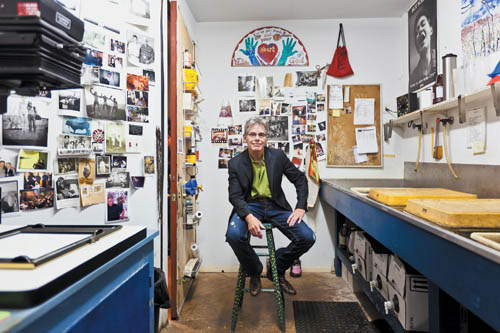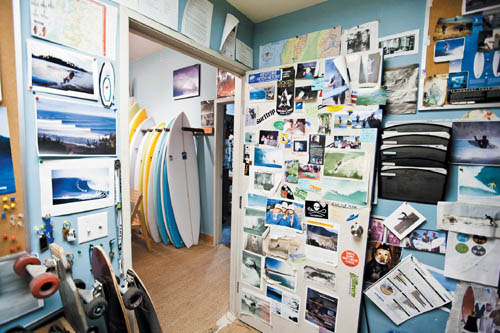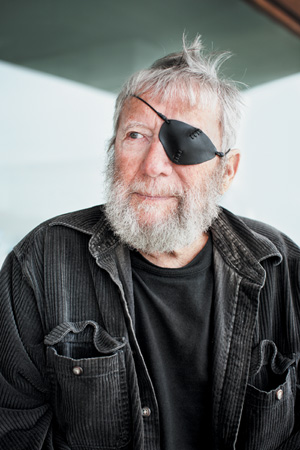8. Resonate

Rather than asking someone to act or perform, sometimes letting them be works best. Look for those moments just after the subject exhales and faces the camera without putting up a front. Here Timmy Curran, a professional surfer, world traveler, and musician, stops and stands in silence as the train approaches.
Canon 5DMii, 85mm lens, f/2.2
CONTRIVED, FAKE, FRAUDULENT, and insincere: These are qualities that people and cultures across the world reject. We’re hard-wired to value genuine, authentic, and real. Whether at the cinema, viewing photographs, or reading a magazine, we want to believe in what is in front of our eyes. We want the subject or story line to be based on something that isn’t a veneer, that isn’t hollow and thin. We crave substance that is dependable and deep.
This is also true with good literature, nonfiction and fiction alike. We read a book hoping to be swept away by its truthfulness. Yet here is where we encounter an interesting twist. We value the story whether or not the story is fictional. Whether the tale is about Huckleberry Finn or Harry Potter or whether it’s Hemingway’s Moveable Feast, its authenticity comes from how it connects with deeper or larger truths that we know.
With photography and other forms of art, we want our work to have impact and a large reach. With this in mind, we often fall into the trap of creating something novel. Sure, newness is an integral aspect to all good forms of the creative arts, yet the shock factor fades by the week. Sometimes, by tapping into a larger, more enduring truth we create work with a substantial and widespread appeal.
Images with a Long Shelf Life
It’s the art that connects with what we know and hold to be true that has the power to transcend the limits of the page. Here is where we discover one of those great empowering ideas—creating strong photographs is about more than capturing something unique. Rather, it’s the pictures that resonate and have the longest shelf life.
Digesting this idea will change how you make pictures. Rather than trying to shoot to win contests, to gain clients, or to elicit comments on Flickr or your blog, you will make pictures with a different goal in mind. The celebrated author W.H. Auden put it best: “Some writers confuse authenticity, which they ought to always aim at, with originality, which they should never bother about.” When creating pictures of people, authenticity is the key.

In traditional photography the darkroom was the creative epicenter. Here fine art photographer Keith Carter sits in his darkroom. The walls are a like pages from his journal which visually represent personality, passion, loss, connection, and ideals.
Canon 5DMii, 16–35mm lens, f/2.8

Fletcher Chouinard is an artist and surfboard shaper with a distinct style. Step into his office and you can instantly see what interests him most—skateboards, surfboards, waves, friends, maps, and quirky keepsakes from his travels. Fletcher has figured it out—creativity is an outward expression of what’s on the inside. His office is like a visual map of his personality—a telling portrait without him there.
Canon 5DMii, 16–35mm lens, f/2.8
Exercise: Drawing a Visual Map
Good stories resonant and connect with the deeper concepts. Good pictures wake up latent ideas. They bring to the surface something the viewer didn’t know that he knew. For the photographer, making this type of photograph comes from digging into the authentic stories of one’s own life. In this exercise, you will be creating a series of hand-drawn visual maps. Think of this as a way to brainstorm ideas for creating more authentic photographs.
Step 1 Setting the Stage
Visual maps are similar to a tree. The main idea is the trunk with others sprouting like branches and leaves. Begin by visiting visualthesaurus.com to get some ideas. At the Web site, start off by doing two separate word searches on new and true. While our maps won’t be identical to these, the concept is the same. Now that you have an idea of what the maps might look like, it’s time to gather a few supplies. Get out some paper (or poster board) and a good set of colored pens.
Tips
If you aren’t the “art school type,” this kind of exercise may initially seem like fluff. Don’t underestimate the power of taking time to define who you are and what kind of pictures you want to make. I’ve had many resistant students later express gratitude after completing this exercise.
I love teaching, but sometimes the student work that I see is shallow and trite. Rather than developing a voice of their own, these students follow a mainstream trend. This exercise will help you overcome following someone else’s lead.
For an extra challenge, do this exercise with a colleague or peer. Share and compare your maps for an even more profound effect.
Step 2 Visual Map #1—Word Self-Portrait
Choose your favorite colored pen and write your name in the middle of a new page. Select a series of different-colored pens and begin to write adjectives that describe who you are. Here are a few to help you generate your own ideas: edgy, artistic, adventurous, melancholy, thoughtful, optimistic.
Write what first comes to mind and continue writing until you have at least 30 on the page. Try not to judge or critique the words on the page. Then highlight or circle the ones you think fit best and connect the words with lines.
Step 3 Visual Map #2—Tragedy/Loss
Choose a dark-colored pen and write your name in the middle of a new page. Select a muted-color pen and write down a nutshell version of the tragedies or loss that you’ve experienced in your life. Include everything from losing your favorite toy in first grade to the more profound. Keep writing until you have included loss from the different stages of your life.
At the bottom of the page add the quote, “From crisis comes opportunity.” Choose a different-colored pen and write notes about how certain challenges have shaped who you are. You don’t need to respond to each loss; just pick a few that have helped you become a stronger or better person.
Step 4 Visual Map #3—Interests/Passions
Write your name in the middle of a new page. Next write down all of the interests, passions, sports, and hobbies that you have pursued throughout your life. Include everything from building a tree fort as a kid to learning how to play the cello as an adult. Make the map as exhaustive as you can, and then go back and circle or highlight the items that stand out most.
Exercise Details
Goal: Create 4 visual maps. Tools: Colored pens and paper. Theme: Becoming in tune with who you are. Duration: 15 minutes per visual map.
Step 5 Visual Map #4—Connections
Write your name in the middle of a new page. Next write down many of your current connections in life. Include people you know through work, family, hobbies, and sport. Continue writing until you have at least 30 on the page. Next, choose a different-colored pen and write down connections that you would like to pursue. For example, ask yourself if there is a travel club you would like to join or a local artist that you would like to meet.
Step 6 Visual Map #5—Goals
Write your name plus the word photography (or your photography business name) in the center of the page. Next, write the photographic goals that you would like to achieve. Don’t worry about whether or not the goals are too outlandish or too small. If a thought crosses your mind, write it down. Include goals about people and places you’d like to photograph. Do you have any publication goals? After you have at least 25 goals on the page, circle or highlight the top 5.
Step 7 Summary
After completing the visual maps, tack them up on your wall. Consider how this can help you make pictures that are more authentically aligned with who you are.
The strongest artists haven’t lived a rosy or privileged life, but are in tune with who they are. They create art from their inner core. By becoming more familiar with the idiosyncrasies, interests, and challenges of your own life, you can begin to authentically take pictures that matter most to you. These visual maps can act as a compass and guide that will lead you to fulfill your inner drive.
Finally, share your maps with a few friends and then write down ten pictures of people that you would like to make. Hold on to this list. You can use it in later exercises in the book.
OPPOSITE After making a visual map of my own, a theme of the sea and surfing kept coming up. I decided to photograph Jack O’Neill, inventor of the wet suit. I wanted to create a portrait of this aging surfer, who made such an impact on those enjoying the frigid waters of the sea.
Canon 5DMii, 16–35mm lens, f/2.8
“Style is a simple way to say complicated things.”
—Jean Cocteau

